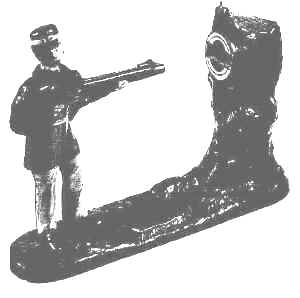Creedmoor Bank
by F.H. Griffith - HOBBIES Magazine - November, 1981
 Collectors of mechanical banks all have their individual
favorites. When it comes, however, to the best known, most popular, and, in their time,
most widely distributed, there are at least three mechanicals that occupy this position.
They are the Creedmoor Bank, Tammany Bank, and Hall’s Excelsior. These are all very
early banks patented in the 1870’s and all three were made over a number of years in
considerable quantities.
Collectors of mechanical banks all have their individual
favorites. When it comes, however, to the best known, most popular, and, in their time,
most widely distributed, there are at least three mechanicals that occupy this position.
They are the Creedmoor Bank, Tammany Bank, and Hall’s Excelsior. These are all very
early banks patented in the 1870’s and all three were made over a number of years in
considerable quantities.
All three, insofar as mechanical banks are concerned, are considered rather common, but try to find all three in original, near mint condition. This is another story. For example, how often do you find a Hall’s Excelsior with the figure having its original arms — or the original bead bell pull — or the paper label in back of the monkey with the wording "cashier?" Different things of comparable nature can be said about both of the other banks, Tammany and Creedmoor.
As we reach No. 293 in the numerical classification, we have chosen the Creedmoor, and the first thing we are going to do is get the background of this unusual name straightened out.
For years the bank’s name has been attributed to a rifle range on
Long Island, New York; this is only part of the story, however. To begin with, a family by
the name of Creed owned property on Long Island. The land amounted to an estate and was
called Creedmoor. Moor is a British term used to denote an expanse of open infertile land,
peaty, and dominated by grasses and sedges
(stubby marsh plants). In England marshes are called moors.
In 1908 the property was deeded over to New York State and it was first used by the American Rifle Club as a rifle range. The surrounding streets were named after rifles, such as Winchester Avenue.
In 1924 the first hospital building was erected on the site as an extension of the Brooklyn State Hospital. This then became the Creedmoor State Hospital, as we know it today.
The Creedmoor Bank was patented by J. H. Bowen of Philadelphia, Pennsylvania, November 6, 1877. It was made by the J. & E. Stevens Company, of Cromwell, Connecticut. They closely followed the configuration and mechanism of the diagrams in Bowen’s patent.
The bank shown is in extra fine all-original condition, with only a few paint chips. Colors are as follows: the figure wears black shoes, gray-blue trousers, red coat, and blue cape. He has a yellow belt and a red hat with a yellow band. His hands and face are flesh color and his hair, eyebrows, eyes, and moustache are black. The gun is black with a gold coin-firing piece. The base is dark green with highlighting in red and yellow. Two raised irregular oval brown sections are on the base. The one by the left foot has the name "Creedmoor Bank" and the patent date "Nov. 6, 1877" cast therein. The other has "Bowen’s Series." The large tree stump is brown with a tan top and a black and white target on the front. So much for the coloring on this attractive bank.
To operate, the coin-firing part is pulled back into position, and in so doing the head tilts forward as though taking aim. A coin is placed to the rear of the gun barrel in front of the firing piece. On pressing the toe of the right foot, the coin is fired into the target, hitting a bell inside the tree. The figure’s head returns to the position as shown in the picture. A nice, conventional action shooting bank.
The bank shown is from the excellent Tudor collection. The writer expresses his appreciation to fellow collector Al Davidson for his help in researching the Creedmoor name.
